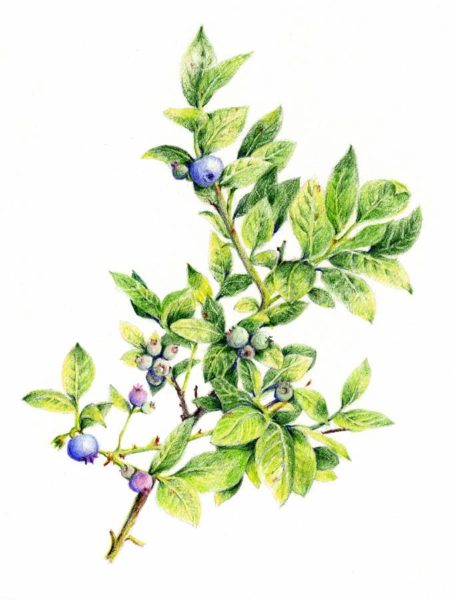Considered the best all-around variety for adaptability, consistent yields, high-quality fruit, and disease resistance, ‘Bluecrop’ is perhaps the most widely planted variety in the US. Large, high-quality fruit ripening mid-season. Plants grow 4-6’ tall in an upright, open growth habit.
An old favorite and versatile variety, ‘Blueray’ performs particularly well in areas with hot summers or very cold winters, and produces high-quality berries with outstanding dessert flavor. The rosy pink flowers turn bright white when in full bloom burgundy foliage in fall. Upright growing habit to 5’ high.
Selected for home gardeners who desire a cold-hardy variety with consistent crops, ‘Patriot’ has a low growing habit that reflects its partial lowbush parentage. It is adaptable to many soil types and makes an excellent landscape variety with its showy white blooms in the spring, dark green summer foliage, and fiery orange-red fall foliage. Large, tangy fruit, ripening early season. Plants grow 3-4’ high in an open, spreading growth habit.
Called a half-high, ‘Northland’ is a highbush x lowbush cross with medium-sized full-flavored berries on a 4’ bush. One of the heaviest producing varieties grown, with higher yields nearing 20 pounds per bush at maturity.
‘Chandler’ is the biggest blueberry you’ve ever seen! This attractive plant produces large, sweet, juicy berries that are delicious fresh. Also suitable for baking. Plants are tolerant of temperatures as low as –15ºF. Fruits mid-to late-season. Ripens in July. Self-pollinating.
At only 3 feet tall, this container blueberry sports hot pink flowers! ‘Sunshine Blue‘ is a cold-hardy variety adapted for vigorous, productive growth in warm and cool climates. Berries are richly sweet and medium-sized and ripen mid to late season.
Our blueberry varieties are self-fertile, but berry production is much improved by mixing at least three cultivars.
SITE: Choose a well drained location in full to partial sun in a loamy or sandy soil with a pH of 4.5-5.2. At planting, dig a hole 18 inches deep and 18 inches wide and mix existing soil 50/50 with mushroom compost, leaf based compost or coir. Place the plant in the hole and fill around root ball with the remaining mix. Set plants 3-4’ apart with rows 6-8’ apart, alternating at least three cultivars for effective cross-pollination. Growth is slow and production will peak at 6-8 years of age.
MULCH: Apply wood-chip mulch generously in a 2’ wide band and a 4” depth.
WATER IS ESSENTIAL: Blueberry bushes have very shallow root systems and are sensitive to water fluctuations. They need at least 1-2” of water each week. In dry seasons, supplemental water is essential to obtain good yields of high quality fruit.
PRUNING: Blueberry plants should have no more than sixteen canes – one or two for each year, up to eight years of growth. This is done by allowing only two canes to grow each year from the time bushes are planted until they are eight years old, when the oldest two canes should be an inch in diameter. Early in the ninth year, the two largest canes and all but the two largest one-year-old canes should be removed. When repeated annually, this technique minimizes uneven growth and production, the oldest canes are continually replaced with the same number of new canes, and the bushes are kept a uniform size. Highbush blueberries will grow up to 4’ tall and yield large berries in late summer.
HARVESTING: Blueberries ripen over several weeks and require two to four pickings. Harvest begins in early July and extends into September depending on the variety, weather and location. To pick by hand, gently roll berries between your thumb and forefinger, removing fully ripe berries and leaving unripe berries for the next picking.
